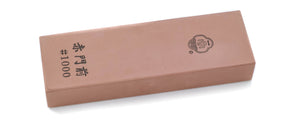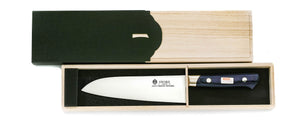Introduction to Japanese Kitchen Knives Part 3: Heat Treatment and Layering
Welcome to Part 3 of our "How to Choose a Japanese Knife" Series.
This part will cover how to choose what construction you want the knife to have. If you want to read the entire journey, go back to Part 1 here.
At this stage we have looked at whether you should get a forged or stamped knife, as well as the blade length, region, and steel you are looking for.
Let's continue helping you discover your knife recipe! Remember, as per Parts 1 and 2 we are looking at chef's knives.
What knife construction types are there?
As we discussed in Part 1, knives are made via forged steel or stamped steel. After either process the steel needs to be changed to make it usable for cooking, done via a process called heat treatment. Think of it like baking a cake; cake mixture needs to be baked to create a structure, otherwise it's just liquid in a bowl that won't work as a cake. Knives need heat treatment, or they won't work properly as knives.
Each forger or factory has its own approach to heat treatment, and it's worth paying attention to - as the heat treatment stage is the most important part of any knife. A VG-10 stainless steel knife that is properly heat treated will vastly outperform one that has had cost cutting measures implemented, or isn't heat treated with the right techniques. To use another cake example, compare a cake made from scratch by a master baker by hand, against a packet cake from the supermarket baked at home, against a microwaved cake in a cup using the same mixture. The end results would all be vastly different. Even if the packet cake had better ingredients, the baker-made cake would very likely turn out better because of the care and expertise taken when baking it. Same analogy works with knives too. No knives in the microwave though, please!
This is one of the key differences between a cheaper knife and a higher end one - they're probably heat treated differently. Good heat treatment equals good quality. And good heat treatment is the most important step of any knife.
How a knife is heat treated depends on many factors, such as steel type, thickness, size, whether it's forged or stamped, and intended layering. There are many layering methods, but the two key ones are mono-layered steel and multi-layered steel.
Temperatures, timing and even ambient temperature influence the heat treatment process, on top of variables like technique, time spent and attention to detail. A knife made by an artisan at the right temperature for the right time will outperform a poorly heat treated, mass-produced knife, even if it has a higher quality steel.
How are kitchen knives heat treated?
Heat treatment has three major steps: Normalizing, Quenching, and Tempering.
Normalizing involves evenly heating the steel to above 1400°C (2552°F) then slowly cooling it. This balances out the steel, removing potential weak points on the knife that appeared during forging. Some knifesmiths will hammer out further distortions by hand to improve the end result.
The steel is then reheated to over 1000°C (1832°F), giving it a bright glow. Quenching involves dipping that steel into oil or water to rapidly cool it. In Japan, smiths often quench with water, sometimes using a special clay coating over the blade too. High end stamped knives will also go through sub-zero quenching.
Quenching makes a knife hard, and is crucial to get right. The best knives in the world have perfect quenching over anything else.
After quenching and another cooling, the steel becomes fragile. Tempering fixes this, removing stress from the steel to increase its durability.
The steel is baked or tempered in an oven with precise temperatures and timing. These determine how the knife will come out, removing brittleness and adding hardness, durability, and edge retention.
Stainless steel reacts differently to carbon steel during this process, so different approaches are required to get similar results.
After this, the knife is ready for cleanup, final sharpening, and polishing!
The above steps are necessary for a good knife. You can cut corners or skip steps in production to reduce cost or mass produce, but the knife won't perform or last as well.
Remember, a knife is more than just its steel. It's how it's made.
What is knife layering?
A knife's composition is also very important! How a knife is layered impacts its strengths and weaknesses. A knife will either be mono-layered, or multi-layered. Our knife making region article goes into great detail, but below is a simple introduction.
A mono-layered knife blade is made from a single hard "core" steel, so expect significantly longer lifespans as they can be sharpened many times - all the way until there's barely any steel left! Mono-layered stamped knives are more common, also known as zenkou or Full Steel knives.
Mono-layered forged knives also exist, known as honyaki knives. Honyaki knives are the pinnacle of knife quality, with their quenching style determining just how high-end they can go. Honyaki and zenkou knives are vastly different in price and performance. Plus, some steels are much harder than others to make honyaki knives from.
A multi-layered knife has an inner layer of core steel cladded by soft iron called nan-tetsu. There are many kinds of multi-layering available; for kitchen knives, you will often see san-mai (either as cladded or double-edge forged) and warikomi (dual composite) styles. San-mai has a full layer of core steel in the middle, with nan-tetsu cladding it. Warikomi has a piece of core steel inserted into a nan-tetsu enclosure. Think of san-mai layering like a sandwich, and warikomi layering like a hotdog, if it helps!
See our table below for some visual examples! Note the Japanese names are there as a reference, but sometimes aren't acutally used in some parts of Japan. We don't use the word "san-mai" in our store for example, we just say clad!
| Cross-section of Double-edged Knife Blade | Name |
| | Mono-layer / Full Steel Zenkou / Honyaki |
| | Clad Kuraddo (San-mai) |
| | Dual Composite Warikomi |
The benefit of multi-layering is nan-tetsu is stronger against impact damage and rust, and costs go down as less core steel is needed. Additionally, honyaki knives are difficult to make and very time consuming - only a few people in the world can do it, even less when it is a water-quenched honyaki (called mizu-honyaki). For example, Nakagawa Satoshi, a famous bladesmith from Sakai only makes around 30 honyaki knives a year! Their lifespan is vastly superior to all other knife kinds, so some people treat honyaki as knives to be passed down for generations.
Exceptions exist, as they always do in the world of kitchen knives. Some steels like Coreless Steel are layered the entire way through! Nan-tetsu is also not the only steel used for cladding either, other steels can be used.
This is the end of Part 3! Now, you should be able to decide how you want your knife to be constructed.
In Part 1, we specified what region we wanted our knife made from. While any knife can be made anywhere, certain regions are famous for certain styles of layering. Sakai is famous for Double-Edge Forging for multi-layering, and Honyaki for mono-layering.
Let's keep that in mind as we update our knife recipe:
I want a double-edge forged, multi-layered Japanese chef's knife made in Sakai, Japan, that has a blade length of 240mm, and is made of VG-10 stainless steel.
One part remains. Join us for Part 4 where we discuss handle-type and finish! You can also read here to learn more about how knives are made!































